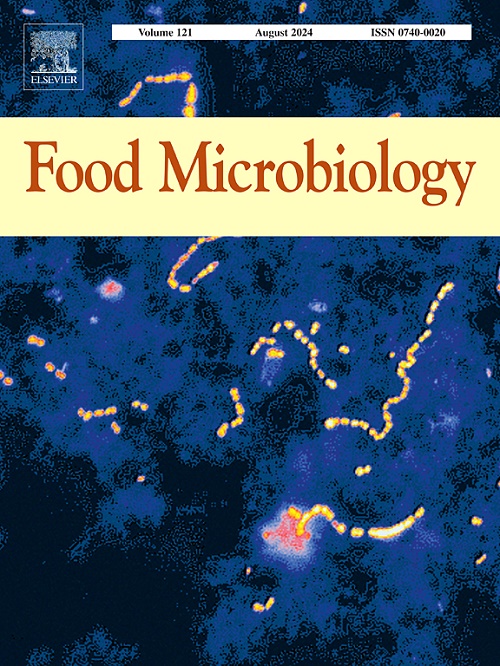比较辣椒(Capsicum)、肉桂(Cinnamomum cassia)和黑胡椒(Piper nigrum)粉末中沙门氏菌的耐热性
IF 4.5
1区 农林科学
Q1 BIOTECHNOLOGY & APPLIED MICROBIOLOGY
引用次数: 0
摘要
热处理是食品工业中用于控制低湿度食品病原体的最有效方法之一。在处理温度下的水活度(aw),而不是室温,是影响微生物热阻的重要因素。本研究评估了辣椒、肉桂和黑胡椒粉末中三株沙门氏菌鸡尾酒的耐热性,这些粉末被预先调节为室温温度0.30或0.50(即21°C = 0.3和0.5)。当这些样品在密封容器中从20°C加热到90°C时,它们的aw增加不同。无论香料类型如何,沙门氏菌的耐热性随aw的增加而降低。在辣椒中,21°C 0.30 (aw,70°C 0.35)和21°C 0.50 (aw,70°C 0.52)样品中沙门氏菌的D70°C值(在给定温度下使90%的细胞失活所需的时间)分别为15.4 min和1.8 min。在相同的21°C温度下,辣椒和肉桂中沙门氏菌的d值显著低于黑胡椒(P <0.05)。然而,根据处理温度,沙门氏菌在肉桂和黑胡椒中表现出相似的耐热性,但在辣椒中表现出较低的耐热性。研究结果强调了在处理温度下测定微生物耐热性的重要性,并表明较温和的温度可能足以控制辣椒粉中的沙门氏菌。本文章由计算机程序翻译,如有差异,请以英文原文为准。
Comparing thermal resistance of Salmonella in chili (Capsicum), cinnamon (Cinnamomum cassia), and black pepper (Piper nigrum) powders
Thermal treatment is one of the most effective methods used in the food industry for pathogen control in low-moisture foods. The water activity (aw) at treatment temperatures, not room temperature, is an important factor influencing microbial thermal resistance. This study evaluated the thermal resistance of a three-strain Salmonella cocktail in chili, cinnamon, and black pepper powders that had been pre-conditioned to room temperature aw of 0.30 or 0.50 (i.e., aw,21°C = 0.3 and 0.5). aw of these samples increased differently in sealed containers when they were heated from 20 to 90 °C. Regardless of spice type, Salmonella thermal resistance decreased with increasing aw. In chili, the observed D70°C-values (the time required to inactivate 90% cells at a given temperature) for Salmonella in the samples of aw,21°C 0.30 (aw,70°C 0.35) was 15.4 min and in the samples of aw,21°C 0.50 (aw,70°C 0.52) was 1.8 min. At the same aw,21°C, the observed D-values of Salmonella in chili and cinnamon were significantly (P <0.05) lower than in black pepper. However, based on aw at treatment temperatures, Salmonella showed similar thermal resistance in cinnamon and black pepper but was less resistant in chili. The findings highlight the importance of aw at treatment-temperature in determining microbial thermal resistance and suggest that milder temperatures may be sufficient for Salmonella control in chili powder.
求助全文
通过发布文献求助,成功后即可免费获取论文全文。
去求助
来源期刊

Food microbiology
工程技术-生物工程与应用微生物
CiteScore
11.30
自引率
3.80%
发文量
179
审稿时长
44 days
期刊介绍:
Food Microbiology publishes original research articles, short communications, review papers, letters, news items and book reviews dealing with all aspects of the microbiology of foods. The editors aim to publish manuscripts of the highest quality which are both relevant and applicable to the broad field covered by the journal. Studies must be novel, have a clear connection to food microbiology, and be of general interest to the international community of food microbiologists. The editors make every effort to ensure rapid and fair reviews, resulting in timely publication of accepted manuscripts.
 求助内容:
求助内容: 应助结果提醒方式:
应助结果提醒方式:


